The streets of Herne Hill are greener and lovelier than ever since Southwark Council planted 43 new trees in the season just ended (November 2023 to April 2024). That makes 227 in the four years that Herne Hill Tree Watch has been campaigning for more tree cover - an average of almost 10 trees for each of the 23 roads we look after. Let's look at the latest tally in a little more detail.
Street by street
In terms of numbers, Carver Road came out on top, with eight new trees. Thanks to our volunteers pushing for more planting and then watering and maintaining the fresh arrivals, both ends of Carver - Herne Hill and Half Moon Lane - have been transformed from being almost barren just a few years ago to much more welcoming now.
Frankfurt Road and Holmdene Avenue followed closely, with seven trees each, then Burbage Road, Danecroft Road and Elfindale Road at four apiece. Elmwood Road and
Hollingbourne Road both have three new saplings, Half Moon Lane two and Delawyk Crescent one.
There's a table of new plantings street by street here.
The species
With global heating getting more intense all the time, we were looking for bigger, more drought-tolerant trees in 2023/24 to provide cooling shade for residents and passers-by. Their dense leaf canopy will capture and store more carbon than small ornamental species and once they're established they'll be better placed to withstand long, hot, dry summers.
The tree officers responded with a menu of 23 different species, which will bring us greater biodiversity and more adaptability to the changing climate. Most of them came from the nursery as stronger, taller, older trees than we've been used to, with a stem circumference of 12-14 cm, known in the trade as heavy standards. Bigger also means they're going to need more water, so don't hesitate to get out your watering cans when you see leaves starting to wilt. You'll find watering guidance in this section of the website.
Going by genus, we've got six new lime trees, six maples, four ginkgos, two beeches, a honey locust, a birch, an alder and a London plane, nearly all of them capable of reaching a good size. On the more decorative side there are eight cherries, four crape myrtles, four magnolias, two hibiscus, one whitebeam, one crab apple and one holly.
A few of the newcomers are native to Britain: the three small-leaved limes, the two beech, the bird cherry and the holly. But being indigenous isn't necessarily as desirable as it seemed a few years ago, when it was seen as the key to attracting and sustaining wildlife. Not all our native flora will thrive in a hot climate or be able to defend themselves against new diseases or pests. It's important now to cast the net further for suitable trees from warmer countries or for selected climate-resistant varieties of oaks, elms and others.
The detailed listings
Starting with the Acers (maples) we're going to list the new plantings in alphabetical order, botanical names first. Each entry will include a brief comment from us and a short edited description, either from 'Cassell's' (Cassell's Trees of Britain and Northern Europe, by David More & John White), from 'RHS' (The Royal Horticultural Society Gardeners' Encyclopedia of Plants and Flowers) or from 'Barcham's' (the Barcham nursery website).
The heights in metres also come from Cassell's, where available, or from growers' websites. The two figures given denote expected height at 10 years and 20 years, but bear in mind that these estimates refer to healthy trees growing in appropriate conditions, not on crowded city pavements with limited space for their roots. And don’t forget our saplings have been growing in the nursery for several years, so a large tree planted this year will already be seven to 10 years old.
The classifications for drought tolerance are mostly from the Forestry Commission's Right Trees For a Changing Climate website. And the photos, all taken in the last week or two, show leaves at their early summer peak. Having an image at hand is much easier than trying to describe a leaf shape, and besides, they're the main feature at this time of year, now the blossom has gone and the autumn fruits and colours might be months away.
Here we go.
Acer buergerianum (Trident maple) - 1 tree
Location: 69 Frankfurt Rd.
Comment: A great little tree to start with. Look at these extraordinary autumn leaf colours from the Trident maple outside 48 Stradella Road.
Description (Cassell's): The species name commemorates J. Buerger (1804-1858), the Dutch plant hunter. The common name describes the shape of the three-lobed leaves. In China and Japan this is an important ornamental tree, a role usually filled in the west by Acer palmatum.
Native to: China.
Height: 2 metres at 10 years, 5 metres at 20 years.
Drought tolerance: Moderately tolerant.

Acer cappadocicum (Cappadocian maple) - 3 trees
Locations:
1 Carver Rd, along the garden fence at the side of 53 Half Moon Lane.
Opposite 38 Carver Rd, between no. 57 and the garages.
11-13 Holmdene Ave.
Comment: There are older examples planted in May 2022 at 36a Carver Rd and in the grounds of the Pynnersmead flats on Herne Hill.
Description (Cassell's): Frequent root suckers always appear around the base of the stem. Acer cappadocicum is common in large gardens and parks and tolerates a wide range of soil and climatic conditions. The leaves emerge reddish, turn brilliant green in summer and colour to butter-yellow in autumn. The cultivar 'Rubrum' (as in the two new trees on Carver) differs only in the colour of the foliage which is purplish-red at first, later turning green. The autumn colour is good yellow.
Native to: Northern Turkey, Iran and the Caucasus.
Height: 3 metres at 10 years, 17 metres at 20 years.
Drought tolerance: Not known.
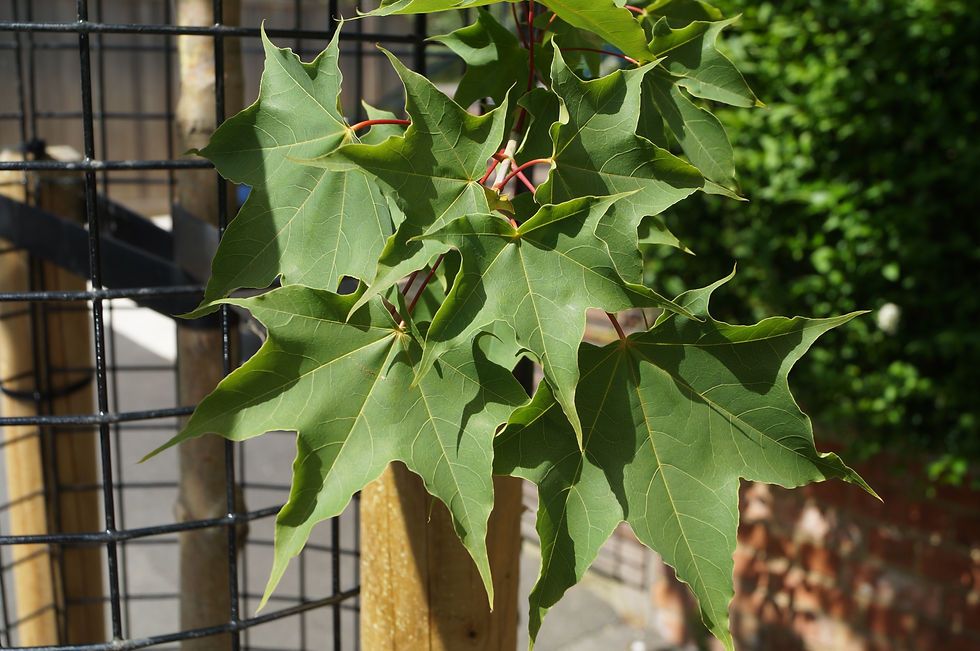
Acer ginnala (Amur maple) - 1 tree
Location: 7-9 Frankfurt Rd.
Comment: There's another Amur maple at the other end of Frankfurt, between no. 71 and 30a Elmwood Rd. This is the poor little tree that was decapitated one night in spring last year, just weeks after being planted. Thankfully it's growing well now, but short and bushy since the leading branch was sawn off.
Description (Cassell's): A large shrub or small tree. The brief autumn colour is bright red. Variegated leaves appear on many specimens from time to time.
Native to: China and Japan.
Height: 2 metres at 10 years, 4 metres at 20 years.
Drought tolerance: Not known.
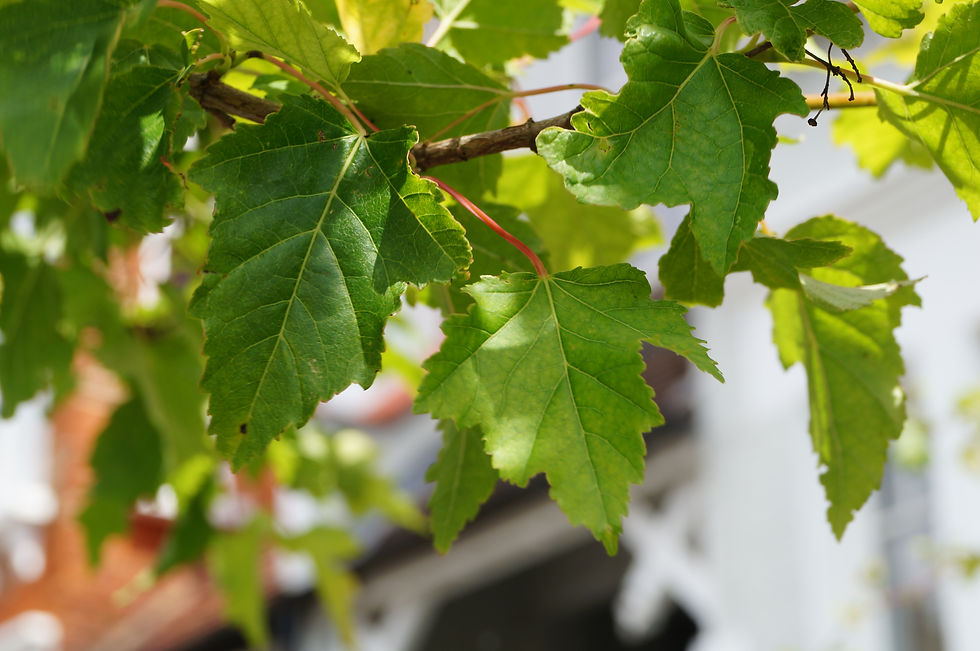
Acer platanoides 'Columnare' (Norway maple) - 1 tree
Location: 17 Burbage Rd.
Comment: Planted on the site of a former Sargent’s cherry, felled in September/October 2023. A columnar cultivar of the standard Norway maple.
Description (Cassell's): This 1878 French selection has fastigiate (upright) branches. The steep branch angle is a disadvantage in urban situations because the weak forks are inclined to eventually break
Native to: Southern Scandinavia across Europe to the Caucasus.
Height: 4 metres at 10 years, 12 metres at 20 years.
Drought tolerance: Moderately tolerant.
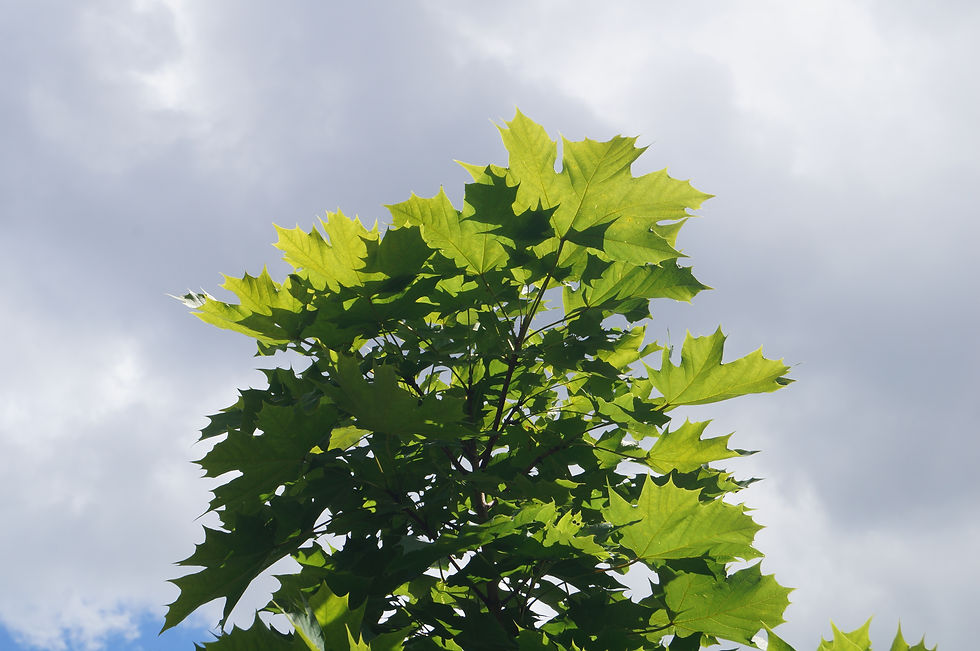
Alnus x spaethii (Spaeth alder) - 1 tree
Location: Near 147 Half Moon Lane, in front of the hedge outside the Elmwood Rd flats, between the lamp post and the driveway.
Comment: Potentially an important contribution to the treescape of Half Moon Lane. Until late 2023 there was another alder (the Alnus incana or grey alder) at 44 Stradella Rd but it was felled by the council. All alders, including the native common alder (Alnus glutinosa) found alongside rivers or streams, bear fat green female catkins that turn dark and woody and hang on the tree like little cones all winter.
Description (Cassell's): This is an artificial hybrid made between Japanese and Caucasian alders in 1908 purely for ornamental purposes. It has the rapid growth of the Caucasian parent combined with the hybrid vigour and narrowish leaves of Japanese alder, which emerge coppery-purple. The late winter male catkins are highly decorative.
Native to: Most alders come from across the northern hemisphere.
Height: 8 metres at 10 years, 18 metres at 20 years.
Drought tolerance: Not known.
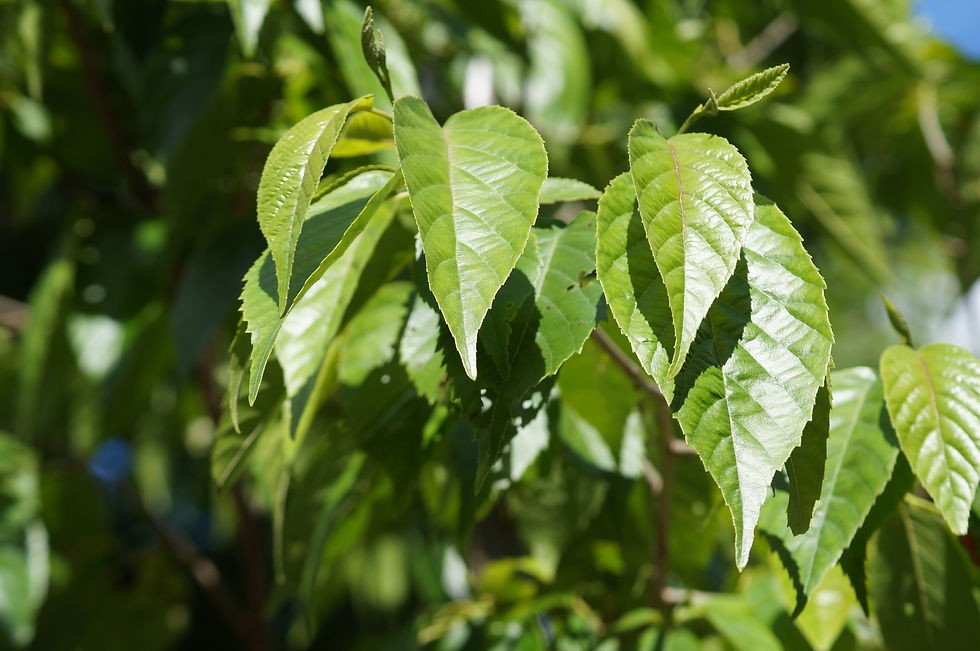
Betula utilis jacquemontii 'Snow Queen' (Snow Queen Himalayan birch) - 1 tree
Location: 6 Frankfurt Rd.
Comment: This is one of many named clones of the white-barked Himalayan birch that has been planted in such profusion in Herne Hill over the last decade. The supplier, Barcham's nursery, says "This particular clone becomes white at an earlier age, approximately three years old."
Description (Cassell's): The parent tree, Betula utilis, has a broad range across the Himalayas, often reaching high into the foothills close to the tree line. Consequently it is extremely variable when brought into cultivation. The horizontally peeling papery bark is usually brown but occasional specimens are pink, copper- coloured and even white. The variety jacquemontii is a white-barked form but is often produced from seed and then the colour is not constant. It grows in northern India and parts of Nepal.
Native to: Western Himalayas.
Height: 5 metres at 10 years, 12 metres at 20 years
Drought tolerance: Intolerant.

Fagus sylvatica pendula (Weeping beech) - 2 trees
Locations:
4-6 Danecroft Rd.
53-55 Elfindale Rd.
Comment: The first street beeches in Herne Hill, although there is a young fastigiate (upright) beech on a grassy plot outside Bessemer Grange school, where Nairne Grove meets Woodfarrs. Identical to the common beech apart from its weeping habit. The leaves, glossy green in spring and summer, turn brown in autumn and stay on the branches all winter.
Description (Cassell's): Although strongly pendulous, with all the shoots apparently pointing straight downwards, this tree manages to grow to huge dimensions. In former times pigs and deer were allowed to feed on fallen beech nuts (mast). In France nuts were also used to fatten poultry, especially turkeys, giving the meat a particular flavour.
Native to: Britain and most of Europe.
Height: 4 metres at 10 years, 10 metres at 20 years.
Drought tolerance: Intolerant.

Ginkgo (Ginkgo biloba) - 4 trees
Locations:
10-12 Carver Rd.
32-34 Carver Rd.
57 Carver Rd.
Opposite 2a Frankfurt Rd, in front of long black fence.
Comment: Another of our commonest street trees where space allows. It first appeared on earth during the Middle Jurassic period, but took until the early 21st century to reach Herne Hill.
Description (Cassell's): The only surviving species of the plant order Ginkgoales, which dominated the tree flora of the world 150-200 million years ago. When first brought to the west from a cultivated source in China in 1689 it was thought to be extinct as a wild plant. Subsequently limited numbers have been found growing naturally in Zhejiang and Guizhou provinces in eastern China. Wild examples of Ginkgo are believed to have occurred in Europe before the current ice ages. The leaves are shaped like duck's feet, and ya-chou-tze (duck's foot) is a Chinese name for it. Male and female flowers, which in the strict botanical sense are not true flowers at all, occur on separate trees, The fruits are plum-like and edible, but with an unpleasant smell.
Native to: China.
Height: 2 metres at 10 years, 5 metres at 20 years.
Drought tolerance: Tolerant.
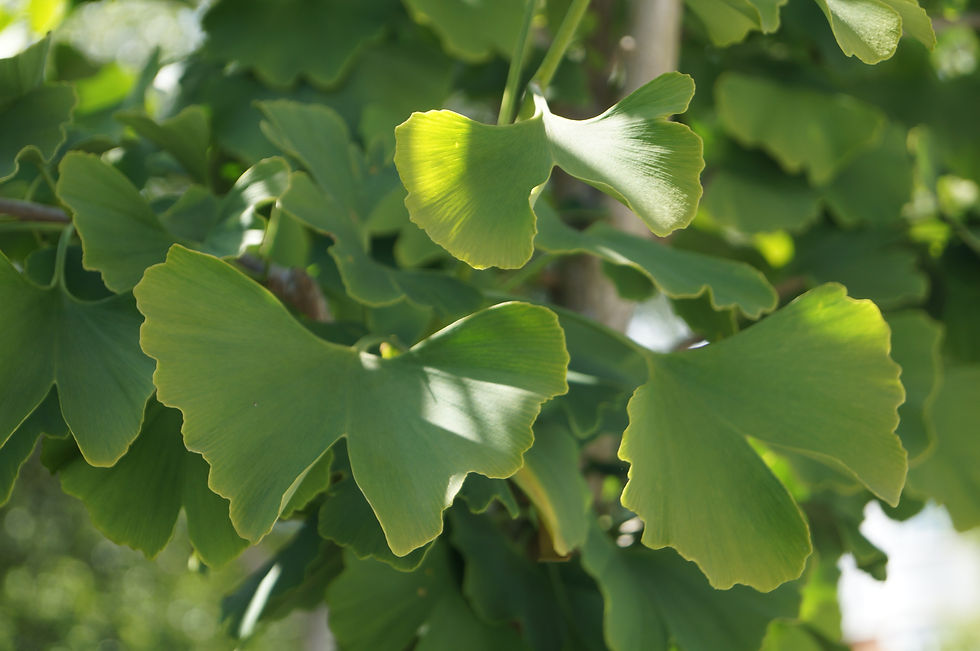
Gleditsia triacanthos 'Skyline' ('Skyline' honey locust) - 1 tree
Location: 2 Holmdene Ave.
Comment: The second of these trees on Herne Hill's streets. The other is a mature specimen, probably the Gleditsia triacanthos 'Sunburst', at 22 Elmwood Rd, seen below right in late May 2023. Sunburst leaves start golden yellow, becoming greener in summer, while Skyline (in the large picture below) starts green and turns bright yellow in autumn.
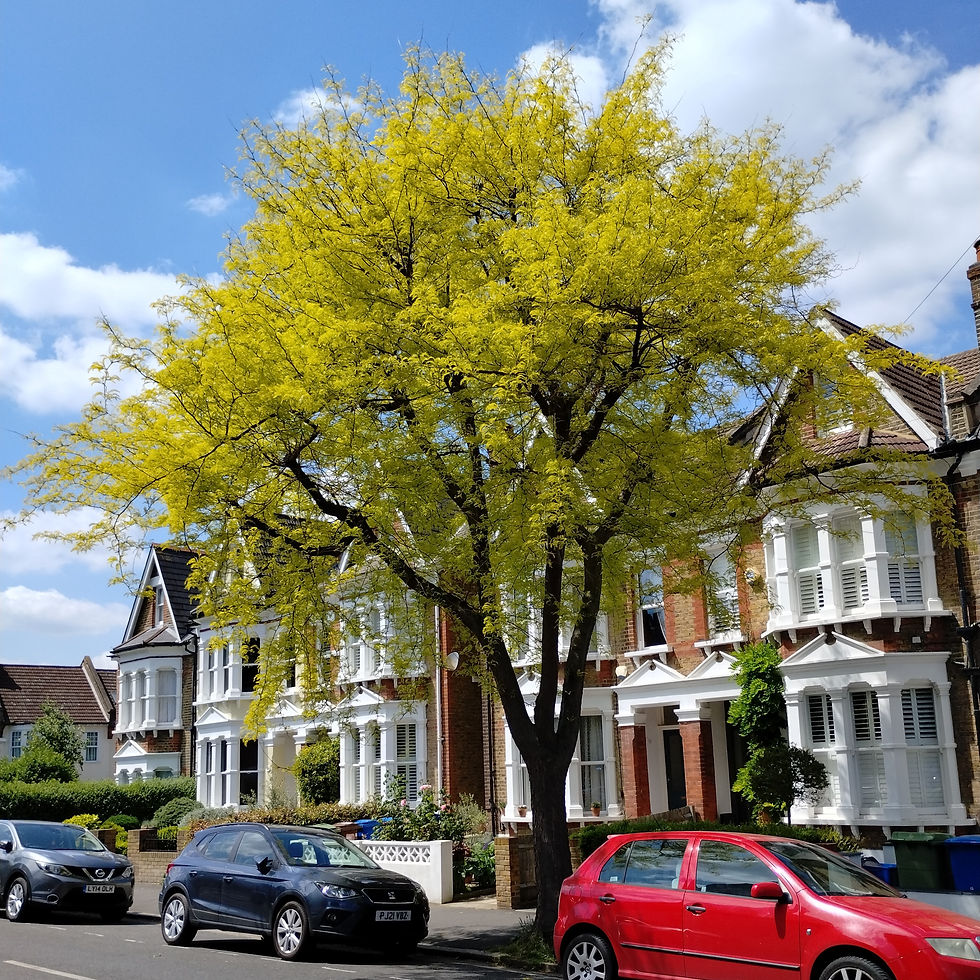
The name 'honey locust' is partly to distinguish it from the unrelated locust tree, Robinia pseudoacacia. They're both members of the pea family and have two features in common: 'pinnate' leaves divided into multiple leaflets along a central stem and fierce spines all over the trunk and branches. Commercially grown Gleditsias have had the thorns bred out of them.
Description (Cassell's): In America it is also called 'Sweet Locust' because the seed pods contain sweet pulp relished by most wildlife.
Native to: East and central North America
Height: 4 metres at 10 years, 10 metres at 20 years.
Drought tolerance: Very tolerant.
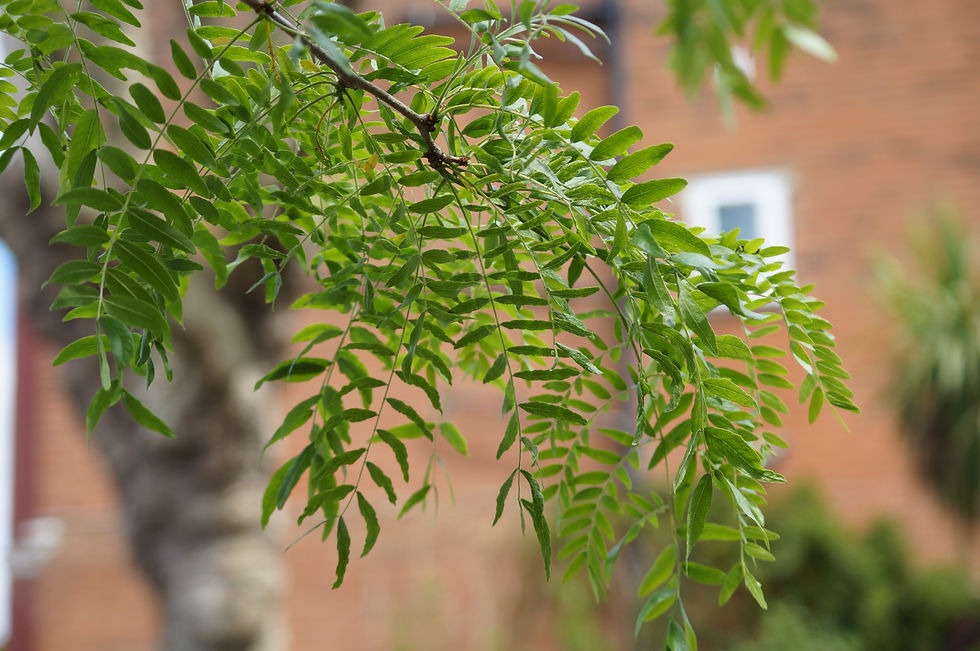
Hibiscus 'Resi' (Hibiscus) - 2 trees
Locations:
41-43 Elmwood Rd
45-47 Elmwood Rd
Comment: These two side-by-side trees make three hibiscus on Elmwood, including a very small one planted two years ago round the corner at the junction of Wyneham Rd. There's another pair on Delawyk Crescent growing against a warm, sheltered wall outside no. 45, one large and vigorous, the other less so, and an older hibiscus at 31-33 Beckwith Rd. People do love their long-lasting pink, lilac or mauve flowers in summer, but we're not convinced of their environmental value.
Descriptions:
(Barcham's): Hibiscus 'Resi', also known as Rose of Sharon, is a hybrid of two species with leaves that resemble a field maple. Large lilac/pink blooms are produced much earlier than more traditionally planted hibiscus varieties and first emerge in July.
(RHS): Needs full sun and humus-rich, well drained soil.
Native to: Various tropical countries.
Height: 3-5 metres at maturity.
Drought tolerance: Not known.

Ilex aquifolium (Common holly) - 1 tree
Location: 27 Danecroft Rd
Comment: This was a real surprise to everybody when it appeared in March. There are two other hollies in a raised stone bed outside 85 Red Post Hill, but that's a more rustic setting. Let's see how this one copes with a real city environment and what shape it develops.
Description (Cassell's): Lower leaves are sharply spined but many of the upper leaves are entire (smooth-edged) except for a spine tip. Alternative berry colours in holly include yellow and orange.
Native to: Europe including Britain, western Asia and North Africa.
Height: 2 metres at 10 years, 8 metres at 20 years.
Drought tolerance: Moderately tolerant.
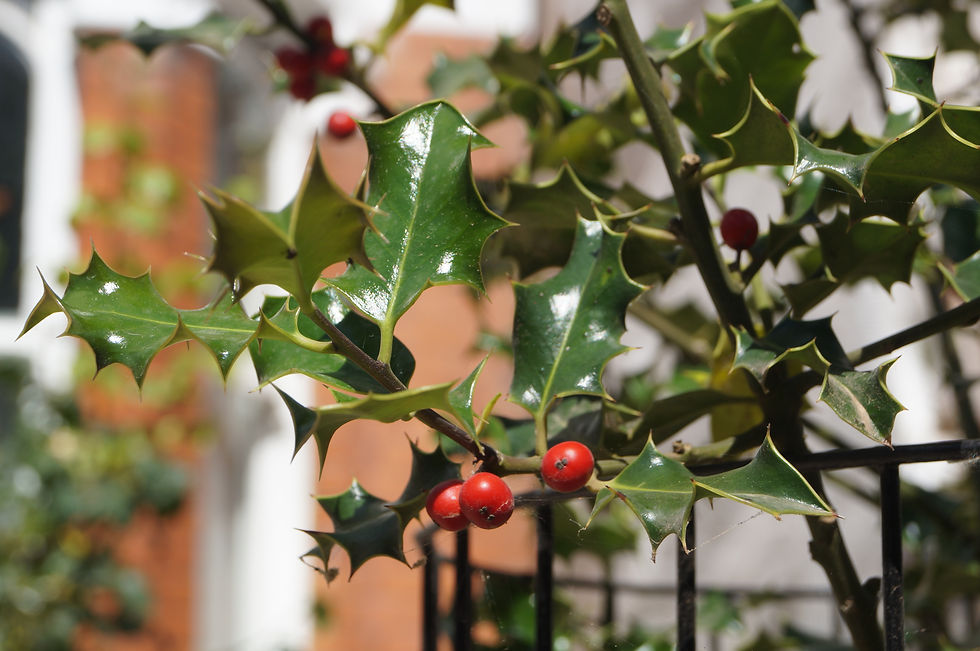
Lagerstroemia indica 'Rosea' (Pink crape myrtle) - 4 trees
Locations:
28 Danecroft Rd.
68-70 Danecroft Rd.
85 Elfindale Rd, outside car park at nos. 83-85.
16-18 Frankfurt Rd.
Comment: These four crape myrtles are going to make a real splash in September when their flowers open. As a teaser, have a look at this one on Crossthwaite Avenue, outside Anijh Supermarket. There's another on Delawyk Crescent, on grass at the side of no. 54.
Description (Barcham's): This attractive tree has small and rounded dark green leaves that turn to a flame red in the autumn time. The bark is simply stunning: mottled with grey and pink colours and smooth-looking after it sheds its outer bark each year. The pretty, deep rose pink flowers appear in late summer, with crimped petals evocative of tissue paper.
Native to: China and Korea.
Height: 3-7 metres at maturity.
Drought tolerance: Tolerant.
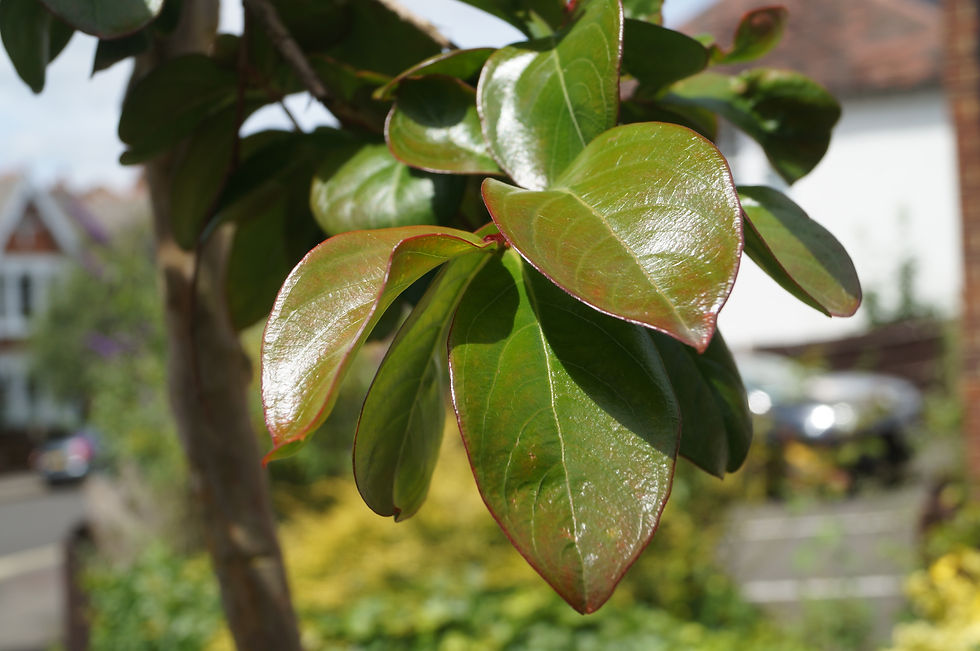
Magnolia kobus (Northern Japanese magnolia) - 4 trees
Locations:
97-99 Burbage Rd.
106 Burbage Rd.
34-36 Frankfurt Rd.
42 Hollingbourne Rd.
Comment: Like the ginkgo, the magnolia is another primitive tree, belonging to the ancient Magnoliaceae order. They evolved in the Cretaceous period 95 million years ago. The only other members of the order are the rare Chinese tulip tree (Liriodendron chinense) and our more common tulip tree (Liriodendron tulipifera), with its very strange leaves (pictured below right).
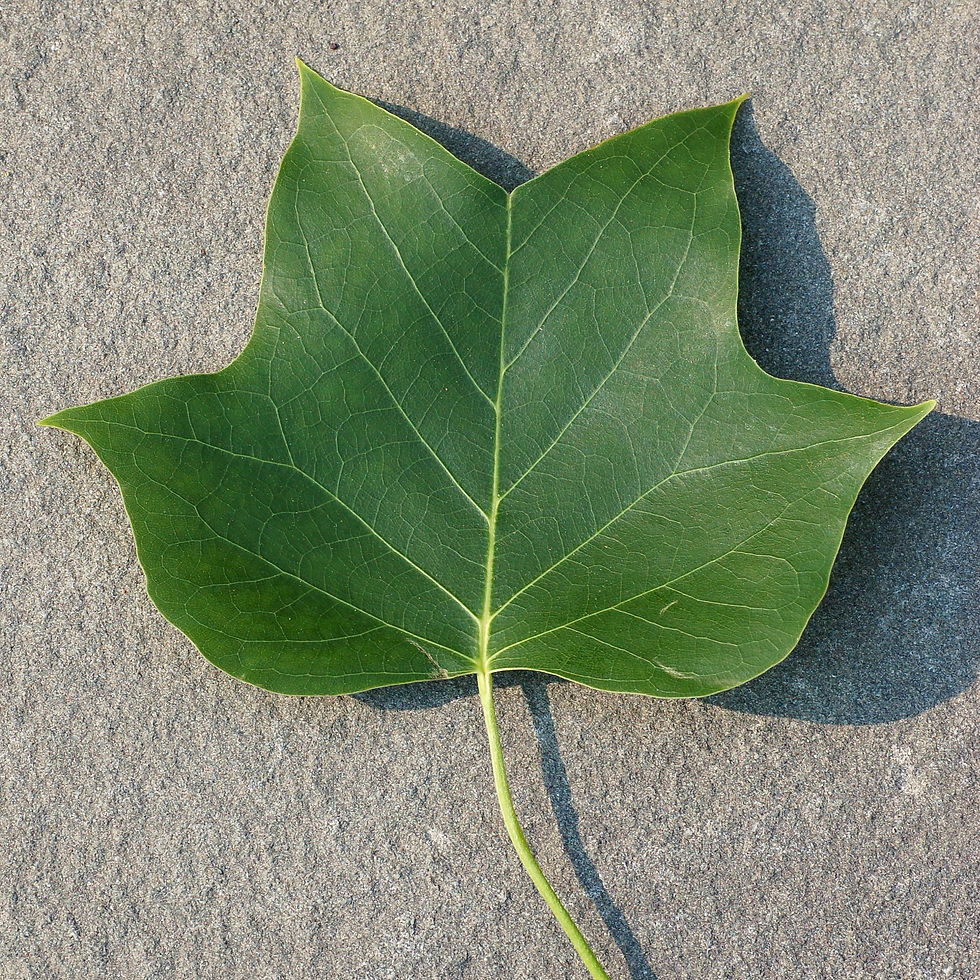
After conquering Casino Ave our magnolias have finally migrated to the western half of SE24. The small white flowers of the kobus don't last long, but they're followed by extraordinary red fruit in late summer and furry leaf buds in wintertime. The leaves (see the large image below) alone are attractive and the twisting branches very pleasing. We looked at these trees in some detail in October 2021.
Description (Cassell's): This Japanese forest tree was introduced first to North America in 1861 then to Europe in 1865. The variety occurs naturally in the region of Hokkaido.
Native to: Japan.
Height: 3 metres at 10 years, 10 metres at 20 years.
Drought tolerance: Not known.

Malus yunnanensis veitchii (Yunnan crab apple) - 1 tree
Location: lawn outside 56 Delawyk Crescent
Comment: Another unusual tree for Delawyk. Unlike most crab apples, the flowers grow in dense clusters standing proud of the leaves, rather like rowans and whitebeams.
Descriptions:
(Cassell's): This tree was discovered by Father Jean Marie Delavay, a missionary and the first European botanist to enter China.
(RHS): Bears white, sometimes pink-tinged, flowers in late spring and a mass of small, red- flushed, brown crab apples in late summer and autumn.
Native to: Yunnan, western China.
Height: 2 metres at 10 years, 6 metres at 20 years.
Drought tolerance: Not known.
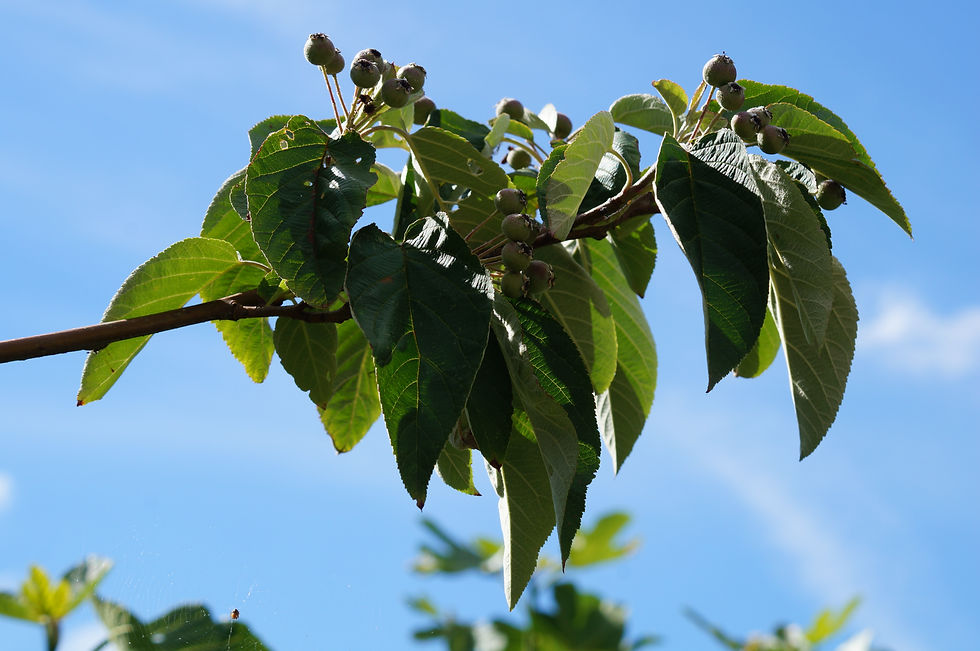
Platanus x hispanica (London plane) - 1 tree
Location: 69 Half Moon Lane.
Comment: This was a 'successional planting', meaning that it will grow to eventually replace a large London plane nearby when it reaches the end of its life. You'll notice the female fruits in the photo, among the maple-shaped leaves.
Description (Cassell's): Fruits, in tight round clusters 2.5cm across, hang down on slender threads singly or up to four in a string. They remain on the tree long after the leaves have fallen.
Native to: This hybrid plane is thought to be a cross between the Oriental plane (Platanus orientalis), found in the region from southeast Europe to India, and the American sycamore (Platanus occidentalis), a native of the central and eastern United States.
Height: 4 metres at 10 years, 18 metres at 20 years.
Drought tolerance: Moderately tolerant.
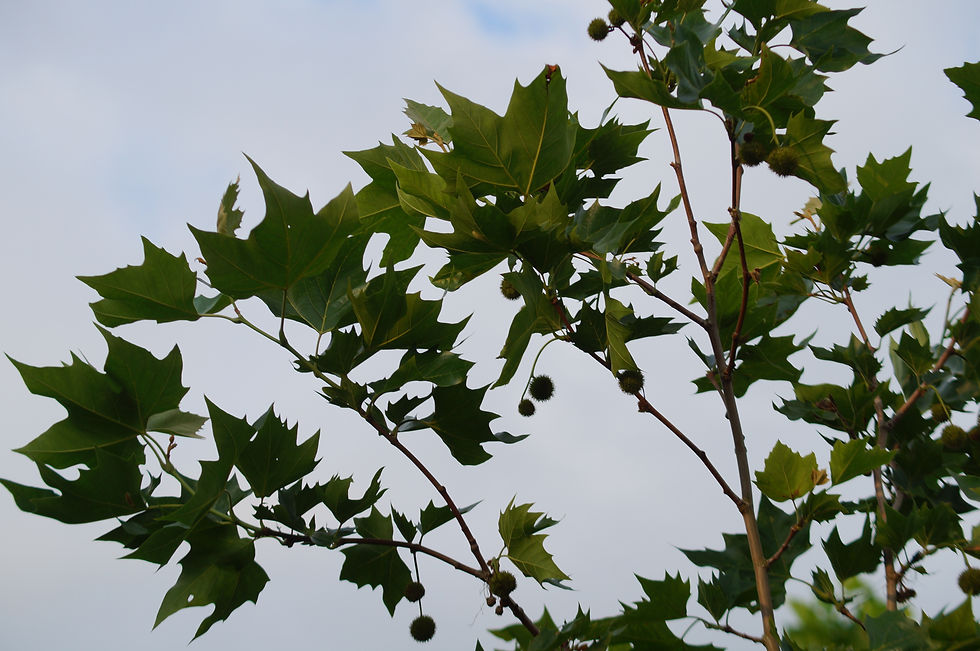
Prunus 'Amanogawa' (Amanogawa cherry) - 2 trees
Locations:
7-9 Hollingbourne Rd.
39-41 Hollingbourne Rd.
Comment: This strictly narrow, late-flowering cherry was one of several cherries featured in our recent spring blossom blog. Also known as the flagpole cherry, it's a good choice for restricted spaces. Its pretty pink and white flowers emerge in April, when most other cherries have already lost their blossom.
Description (Cassell's): The Japanese name means 'celestial river'. Trees up to 6-8 metres tall may be only 50 cm wide.
Native to: Japan
Height: 3 metres at 10 years, 7 metres at 20 years.
Drought tolerance: Not known.
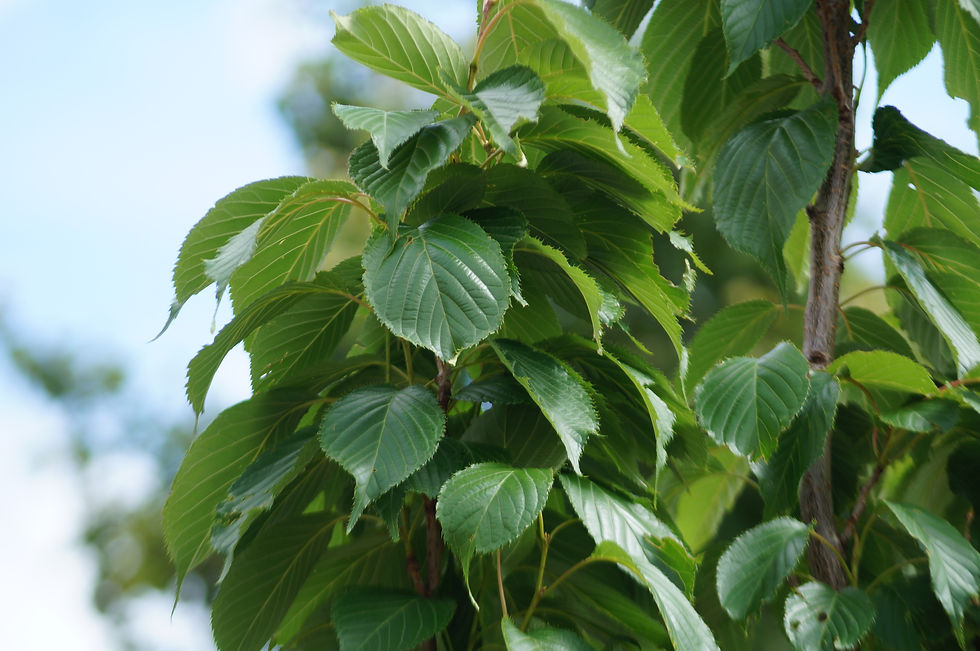
Prunus padus (Bird cherry) - 1 tree
Location: 69-71 Holmdene Ave
Comment: This is one of the few cherries where the flowers cluster along a common stalk called a raceme. Like the amanogawa, it too blooms late, in April. There's only one other bird cherry that we know of in Herne Hill, a purple-leaved variety at 21 Carver Rd, probably Prunus Padus ‘Colorata’. As we write there's a dense thicket of green, not purple, shoots around the base of the Carver tree where it would have been grafted on to a standard bird cherry rootstock.
Description (Cassell's): The 1 cm fragrant white flowers are followed by a smaller number of glossy black, ovoid, bitter fruits which are quickly taken by birds, hence the name. The leaves usually turn to orange-red in the autumn.
Native to: Britain, Europe and northern Asia.
Height: 3 metres at 10 years, 7 metres at 20 years.
Drought tolerance: Intolerant.
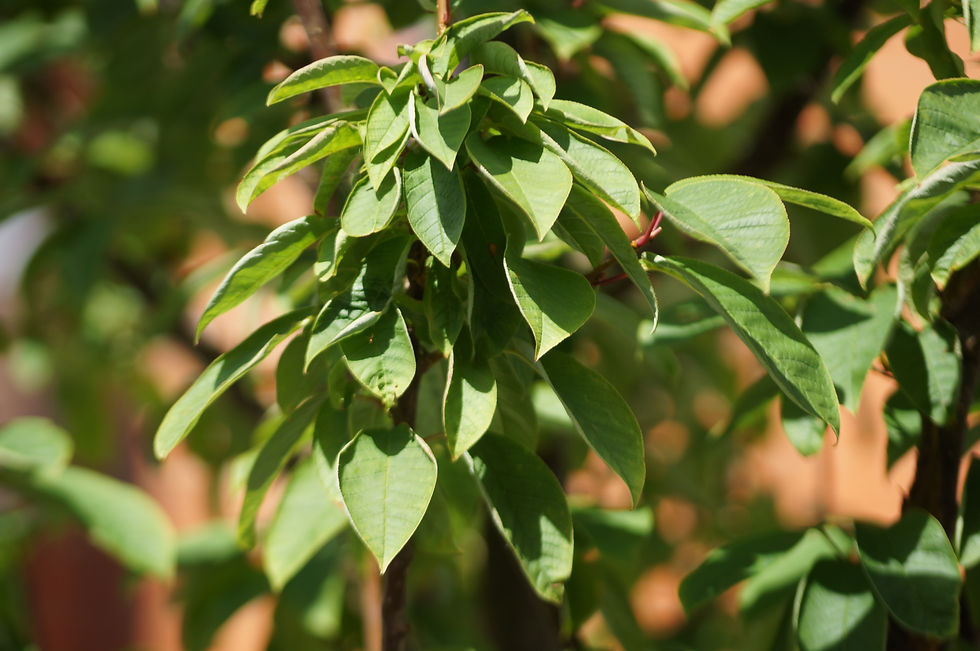
Prunus sargentii (Sargent's cherry) - 2 trees
Locations:
2 Carver Rd, along the garden fence of 51 Half Moon Lane.
2a Frankfurt Rd, at the side of 63 Herne Hill, by the wooden fence to the backyard of Petermans estate agents.
Comment: The big cherry in front of Pizza Express at the corner of Milkwood Road and Herne Hill is a Sargent's.
Description (Cassell's): In spring it produces a great unmistakable cloud of brilliant rose-pink 3-4 cm single flowers. In the autumn the whole tree becomes a ball of fiery- red and orange foliage. It is also one of the few flowering cherries that regularly produces some fruit: 1 cm long-stalked gems of glossy yellow, orange, red and purple-black.
Native to: Japan, Sakhalin and Korea.
Height: 3 metres at 10 years, 10 metres at 20 years.
Drought tolerance: Intolerant.
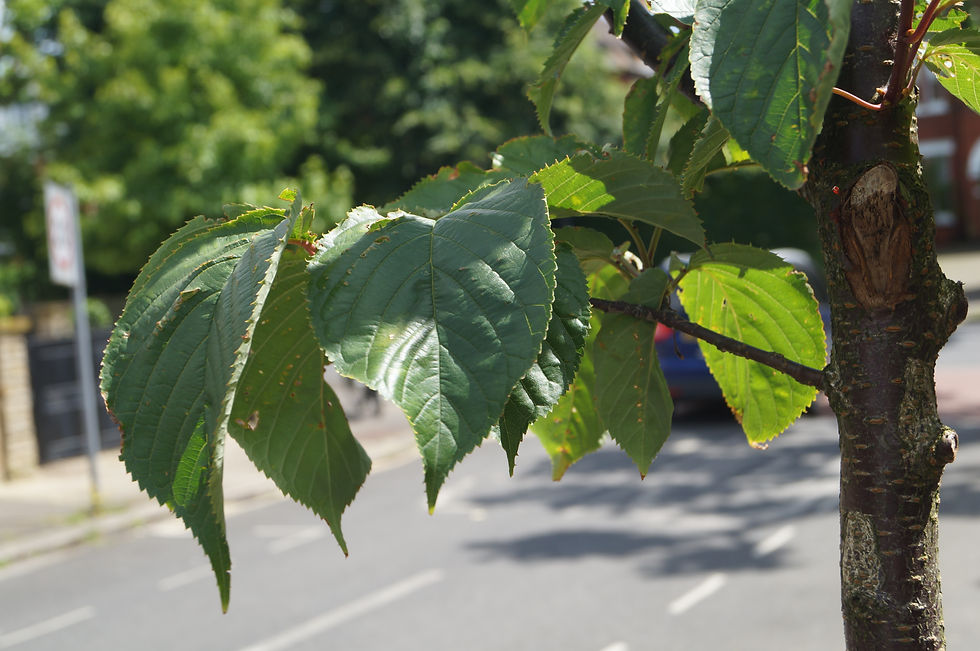
Prunus x schmittii (Hybrid cherry) - 1 tree
Location: 30 Elmwood Rd.
Comment: The only tree of its kind in Herne Hill, noted more for its shiny bark than its pink flowers. It was planted where a diseased London plane stood until November 2022.
Descriptions:
(Cassell's): A fast-growing hybrid between the wild cherry (Prunus avium) and the grey-leaf cherry (Prunus canescens), this is a lovely Chinese tree with dark mahogany brown bark.
(Barcham's): Prunus schmittii has stiffly ascending branches to form a narrow but large conical crown even at maturity. It shows fine autumn colours
Native to: China.
Height: 3 metres at 10 years, 9 metres at 20 years.
Drought tolerance (wild cherry parent): Intolerant.
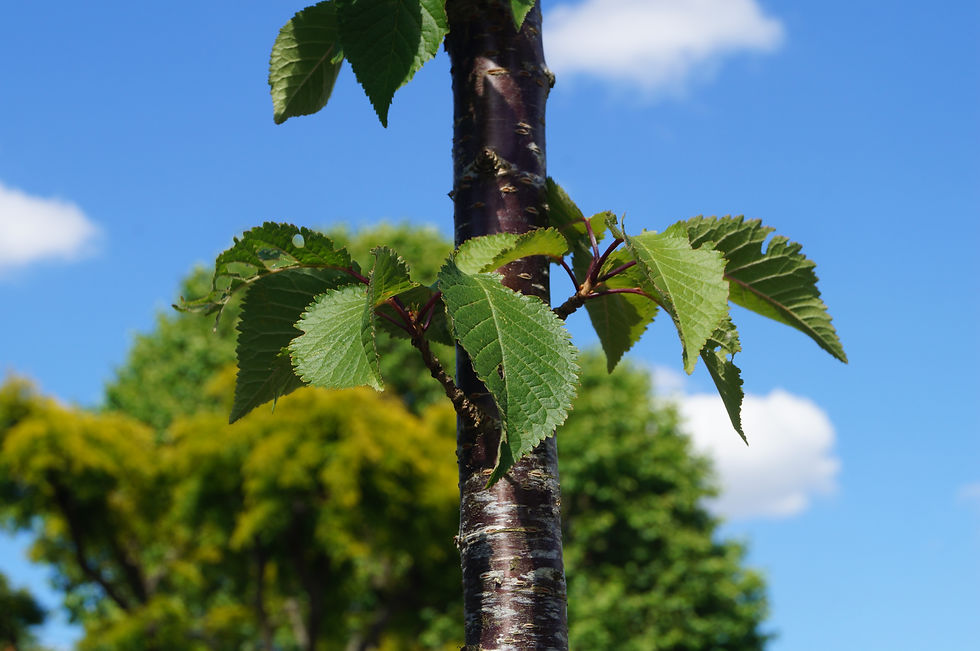
Prunus 'Sunset Boulevard' (Sunset Boulevard cherry) - 2 trees
Locations:
35-37 Elfindale Rd.
56-58 Elfindale Rd.
Comment: These two join our growing collection of Sunset Boulevards. The others were all planted in 2020/21: two at the top end of Elfindale and one on Sunray Avenue, on the grass verge near St Faith's church where a London plane previously stood. The big white flowers, shown on the left of this photo in our Spring 2024 blog, are outstanding, but the tree doesn't produce fruit.
Description (Barchams): This relatively new introduction was bred at the Arboretum Kalmthout Belgium in the late 1980s for urban use. Its young coppery foliage turns green in summer and golden yellow in autumn and its large white single flowers are edged with pink.
Native to: Japan and China
Height: 7-12 metres at maturity.
Drought tolerance: Not known.
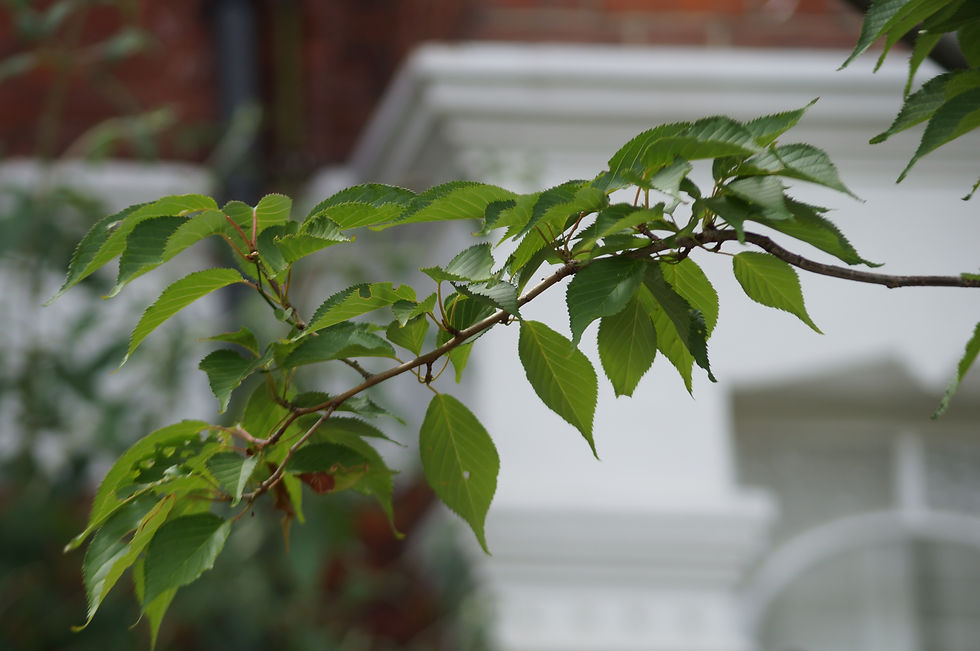
Sorbus intermedia 'Brouwers' (Swedish whitebeam) - 1 tree
Location: 17 Burbage Rd.
Comment: We looked at the most commonly planted species of Sorbus - the whitebeam, the Swedish whitebeam, the rowan and the bastard service tree - in our Spring 2024 blog. The lobed leaves of the Swedish whitebeam (top right in this photo) make it easy to differentiate from the three others.
Descriptions:
(Cassell's): Swedish whitebeam tolerates severe climatic conditions, notably in Norway, Denmark and Scotland, and it is the only broadleaved tree that really thrives on Orkney and Shetland. The oval fruits, in conspicuous bunches, are brownish then red.
(Barcham's): Sorbus intermedia 'Brouwers' is a clonal variation of the Swedish whitebeam which, like many clones in general, produces a reliable crown that is regular and pyramidal and offers little variation between individual trees.
Native to: Sweden, the Baltic States and northern Poland.
Height: 3 metres at 10 years, 8 metres at 20 years.
Drought tolerance: Moderately tolerant.

Tilia cordata 'Greenspire' ('Greenspire' small-leaved lime) - 3 trees
Locations:
Near 7 Carver Rd, along the Leyland cypress hedge.
5-7 Holmdene Ave.
6 Holmdene Ave.
Comment: The flowers of the 'Greenspire', like all limes, smell sweet. Before they disappear, try walking along Burbage Rd and whenever you see a lime in flower have a sniff. The fragrance is still strong at the Half Moon Lane end.
Descriptions:
(Cassell's): Probably the ultimate narrow small-leaved lime is 'Greenspire', raised in America in 1961. It has upright branches and a very narrow crown. If limes have any place in town parks and streets this is the most suitable cultivar to use. It is very wind-firm and the fallen leaves rot down quickly.
(Barcham's): This tree has small and shiny heart-shaped (cordate) leaves which are dark green on the surface and light green on the underside. The creamy-coloured, fragrant flowers appear in early summer and in autumn the foliage turns a golden yellow. It will survive planting in a range of soil conditions, including heavy clay and urban conditions.
Native to: Europe including Britain, much of Russia.
Height: 12-17 metres at maturity.
Drought tolerance: Moderately tolerant.
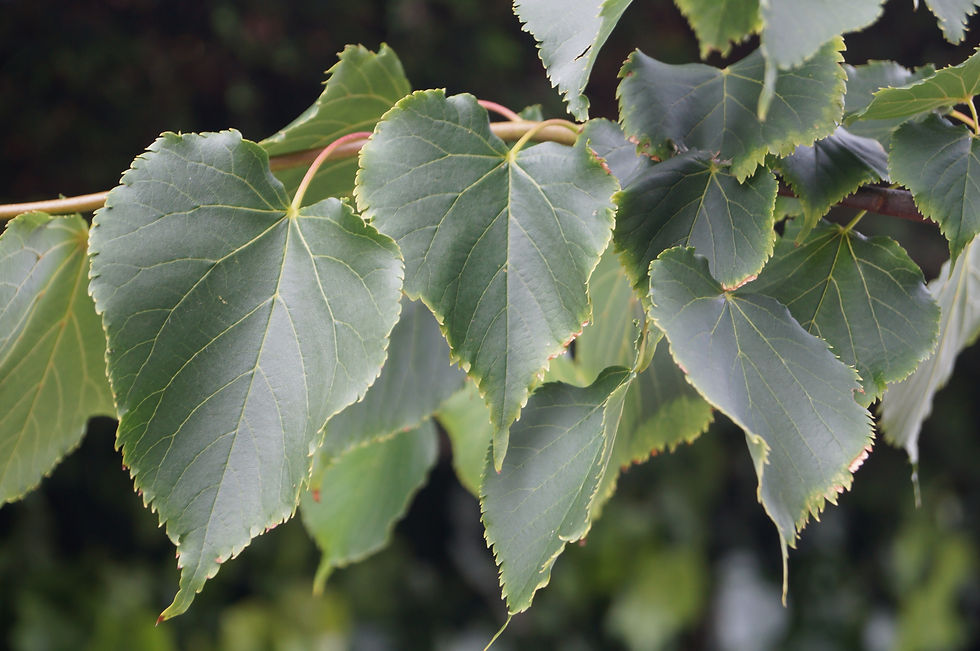
Tilia x euchlora (Caucasian lime) - 3 trees
Locations:
Near 38 Carver Rd, outside garden of 157 Herne Hill.
24-26 Holmdene Ave.
96 Holmdene Ave.
Comment: This hybrid is the lime to plant if you want to avoid the sticky honeydew that drops on to parked cars and pavements. It's also known as Crimean lime.
Description:
(Barcham's): The fragrant creamy-yellow flowers appear in late spring, followed by bright yellow/orange leaf colour in autumn.
(Cassell's): Tilia x euchlora is an unmistakable tree with brilliant glossy deep green leaves and pendulous lower branches. The foliage does not suffer from the aphid infestations that result in black fungus-infested honeydew in other limes. Over-indulgent bees may become intoxicated with an excess of nectar from the flowers, but most of them survive.
Native to: The parent trees are Tilia cordata (native to Europe including Britain, much of Russia) and Tilia dasystyla (from Caucasus, northern Iran, Crimea).
Height: 3 metres at 10 years, 12 metres at 20 years.
Drought tolerance: Moderately tolerant.
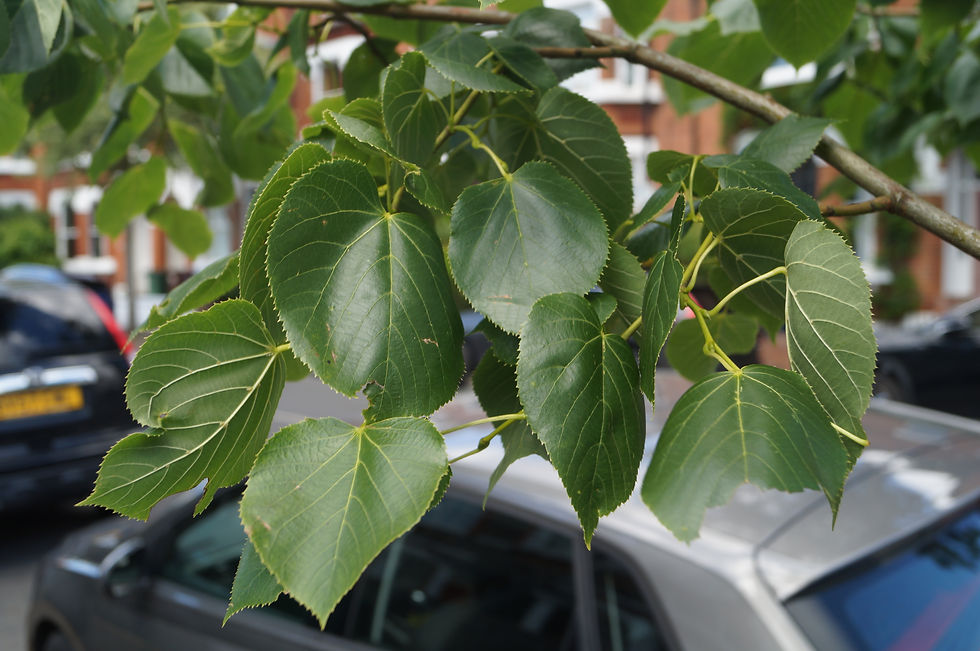
Comments